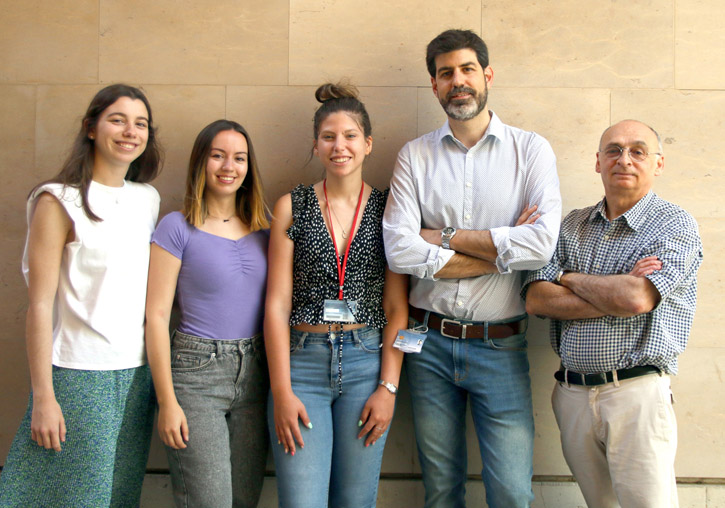The University of Valencia and INCLIVA investigate advanced therapies for Dravet Syndrome, a rare childhood epilepsy
- Scientific Culture and Innovation Unit
- May 24th, 2022

The University of Valencia (UV) and the INCLIVA Health Research Institute, of the Clínic Hospital of Valencia, have launched a research line with the Dravet Syndrome Foundation to promote the development of advanced therapies on Dravet Syndrome, a rare childhood epilepsy of genetic origin that causes severe retardation and cognitive, motor, behavioural and speech problems. Today, May 24, is the National Epilepsy Day, a condition associated with multiple illnesses of the central nervous system, which affects around 400,000 people in Spain.
Dravet Syndrome is a rare childhood epilepsy that begins in the first year of life and usually has a drug-resistant character. It is accompanied by a series of severe neurodevelopmental disorders and greatly affects the quality of life of patients and families.
Carlos Romá Mateo, professor of the Department of Physiology of the UV and member of the Research Group in Cellular and Organic Physiopathology of Oxidative Stress of INCLIVA, coordinated by Federico Pallardó – professor of Physiology and group leader of the Centre for Biomedical Network Research on Rare Diseases (CIBERER)–, is the director of the INCLIVA-UV for this new collaboration.
Romá is, moreover, the main researcher of Lafora’s research line on epilepsy, developed at INCLIVA and CIBERER during the last years, in close collaboration with the Pascual Sanz group at the Institute of Biomedicine of Valencia (IBV-CSIC) and the CIBERER, with the aim of understanding more of this rare illness and finding new therapeutic guidelines to advance precision medicine, offering a personalised treatment, adapted to each patient. Progressive myoclonic epilepsy of the Lafora type is a neurodegenerative illness with rapid progression and fatal outcome, for which there is currently no cure or treatment that advises more than endangering and palliating its effects.
The collaboration with the Dravet Syndrome Foundation –which has led, moreover, to the inclusion of Carlos Romá in a European work group to coordinate research efforts on this pathology– stems from the previous studies carried out for the treatment INCLIVA’s research group on Lafora’s illness, since Dravet syndrome shares some traits at the molecular level and could offer new scientific data that will help to better understand the development of the illness and guide new therapeutic strategies.
Epilepsy occurs when there is a lack of coordination in the communication between nerve cells, which gives rise to uncontrolled excitation phenomena that manifest themselves in many different ways. The best known one is the generation of involuntary muscle contractions and spasms, however, there are many different forms of epileptic phenomena that can range from alterations in neuronal connectivity that are reflected in alterations in brain waves during sleep, only recordable by electroencephalography, to generalised convulsive crises of great severity and fatal consequences.
In the case of Lafora epilepsy and Dravet Syndrome, it is crucial to have analysis tools that allow not only early and accurate diagnoses, but also monitoring and prognosis of symptoms that are adjusted to the particularities of each patient. The line of research in epilepsy being developed by INCLIVA-UV, explains Dr. Romá, “is the result of combining the experience accumulated in the study of the molecular bases of a low-prevalence epilepsy with a complex genetic background, with the findings about the value of circulating microRNA-type molecules or proinflammatory cytokines as biomarkers capable of accurately monitoring both the progression of diseases and the efficiency of treatments”.
Based on the analysis of the molecular pathways involved in regulating cellular oxidative stress, the INCLIVA-UV Cellular and Organic Physiopathology of Oxidative Stress Research Group has, in recent years, delved into the relationships between these pathways and the pathophysiology of many rare diseases, due to genetic defects that lead to alterations in cell function.
These investigations have discovered that many of the molecules involved in these defects, sometimes indirectly, can be used as a guide to better understand both the symptoms and the progression of some worsening diseases, such as Lafora epilepsy. Currently, it is being verified that some very relevant molecules in inflammatory processes as disparate as those that give rise to different types of sepsis also play an important role in the characteristic neuroinflammation of Lafora disease model mice, so they keep investigating their possible value as the disease biomarkers in human patients.
File in: Recerca, innovació i transferència , Difusió i comunicació científica , Grups de recerca , Facultat de Medicina i Odontologia , Internacionalització recerca , Investigació a la UV
















